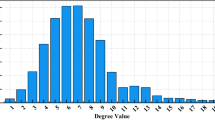Abstract
This study proposes an integrated model based on small world network (SWN) and multi-agent system (MAS) for simulating epidemic spatiotemporal transmission. In this model, MAS represents the process of spatiotemporal interactions among individuals, and SWN describes the social relation network among agents. The model is composed of agent attribute definitions, agent movement rules, neighborhoods, construction of social relation network among agents and state transition rules. The construction of social relation network and agent state transition rules is essential for implementing the proposed model. The decay effects of infection “memory”, distance and social relation between agents are introduced into the model, which are unavailable in traditional models. The proposed model is used to simulate the transmission process of flu in Guangzhou City based on the swarm software platform. The integration model has better performance than the traditional SEIR model and the pure MAS based epidemic model. This model has been applied to the simulation of the transmission of epidemics in real geographical environment. The simulation can provide useful information for the understanding, prediction and control of the transmission of epidemics.
Similar content being viewed by others
References
Kermack W O, McKendrick A G. A contribution to the mathematical theory of epidemics. In: Proceedings of the Royal Society of London (Series A). London: The Royal Society, 1927. 700–721
Ma Z N, Zhou Y C, Wang W D, et al. Mathematical Modeling and Dynamics of Infectious Diseases (in Chinese). Beijing: Science Press, 2004. 3–9
Shi Y L. Stochastic dynamic model of SARS spreading. Chinese Sci Bull, 2003, 48: 1287–1292
Wang H Y, Rong F, Ke F J, et al. Control dynamics of severe acute respiratory syndrome transmission. Chinese Sci Bull, 2003, 48: 2684–2687
Stefano B D, Fukś H, Lawniczak A. Object-oriented implementation of CA/LGCA modelling applied the spread of epidemics. In: Proceedings of the IEEE Canadian Conference on Electrical and Computer Engineering. Halifax: IEEE. 2000. 26–31
Fu S C. Modelling epidemic spread using cellular automata. Dissertation for the Master Degree. Perth: University of Western Australia, 2002. 27–49
Mikler A R, Venkatachalam S, Abbas K. Modeling infectious diseases using global stochastic cellular automata. J Biol Syst, 2005, 13: 421–439
Zhang P, Atkinson P M. Modelling the effect of urbanization on the transmission of an infectious disease. Math Biosci, 2008, 211: 166–185
Moore C, Newman M E J. Epidemics and percolation in small-world networks. Phys Rev E, 2000, 61: 5678–5682
Chebeane H, Echalier F. Towards the use of a multi-agents event based design to improve reactivity of production systems. Comput Ind Eng, 1999, 37: 9–13
Li X, Yeh A G O, Liu X P, et al. Geography Simulation System: Cellular Automata and Multi-agent (in Chinese). Beijing: Science Press, 2006. 250–258
Liu X P, Li X, Yeh A G O. Multi-agent systems for simulating spatial decision behaviors and land-use dynamics. Sci China Ser D-Earth Sci, 2006, 49: 1184–1194
Zhang H H, Zeng Y N, Jin X B, et al. Urban land expansion model based on multi-agent system and application (in Chinese). Acta Geogr Sin, 2008, 63: 869–881
Liu Y, Chen Y. Simulation and analysis on the control of SARS by complexity adaptive system theory (in Chinese). Complex Sys Complexity Sci, 2004, 1: 74–79
Deng H Z, Chi Y, Tan Y J. Multiagent-based simulation of disease infection (in Chinese). Comput Sim, 2004, 21: 167–170
Morrill R L, Angulo J J. Spatial aspects of a smallpox epidemic in a small brazilian city. Geogr Rev, 1979, 69: 319–330
Bian L. A conceptual framework for an individual-based spatially explicit epidemiological model. Environ Plann Plann Des, 2004, 31: 381–395
Gong J H, Zhou J P, Xu S, et al. Dynamics model and multi-agent based simulation of SARS transmission (in Chinese). J Remote Sens, 2006, 10: 829–835
Milgram S. The small world problem. Psych Today, 1967, 1: 60–67
Watts D J, Strogatz S H. Collective dynamics of ’small-world’ networks. Nature, 1998, 393: 440–442
Wang J F. Spatial Analysis (in Chinese). Beijing: Science Press, 2006. 221–232
Anderson R, May R. Infectious Diseases of Humans: Dynamics and Control. Oxford: Oxford University Press, 1991. 467–630
Dodds P S, Watts D J. Universal behavior in a generalized model of contagion. Phys Rev Lett, 2004, 92: 218701
Wang X F, Li X, Chen G R. Complex Network and Its Application (in Chinese). Beijing: Tsinghua University Press, 2006. 9–23
Newman M E J, Watts D J. Renormalization group analysis of the small-world network model. Phys Lett A, 1999, 263: 341–346
Bailey T C, Norman T J. The Mathematical Theory of Infectious Diseases and Its Applications. New York: Oxford University Press, 1975. 6–42
Wang J F, McMichael A J, Meng B, et al. Spatial dynamics of an epidemic of severe acute respiratory syndrome in an urban area. B World Health Organ, 2006, 84: 965–968
Zeng Y. Population Analysis Method and Its Application (in Chinese). Beijing: Peking University Press, 1993. 47–124
Wang G Z. User Manual for CPPS (in Chinese), 2002
Tian Y, Yue T, Zhu L, et al. Modeling population density using land cover data. Ecol Model, 2005, 189: 72–88
Clark C. Urban population densities. J R Stat Soc A Stat, 1951, 114: 490–496
Xie S H, Ning Y M. Modeling the spatial distribution of urban population density and its evolution in Guangzhou (in Chinese). Appl Stat Manage, 2006, 25: 518–522
Author information
Authors and Affiliations
Corresponding author
About this article
Cite this article
Liu, T., Li, X. & Liu, X. Integration of small world networks with multi-agent systems for simulating epidemic spatiotemporal transmission. Chin. Sci. Bull. 55, 1285–1293 (2010). https://doi.org/10.1007/s11434-009-0623-3
Received:
Accepted:
Published:
Issue Date:
DOI: https://doi.org/10.1007/s11434-009-0623-3




